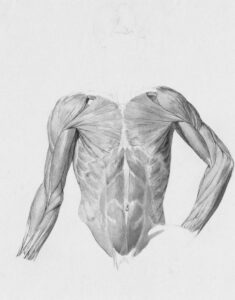
Let’s See How The Science Of Muscle Recovery Really Works?
What Happens During and After a Workout?
- Microscopic Muscle Damage
- Strength training exercise can cause small tears in muscles fiber.
- This is a norTiny Tearing of muscles are totally normal in muscle building.
- Inflammation Response
- Once body notice the damage it sends the immune cells to repair the damage.
- You might feel DOMS (Delayed Onset Muscle Soreness) 24–72 hours after a workout.
- Muscle Protein Synthesis (MPS)
- Your body begins rebuilding the damaged fibers, making them thicker and stronger.
- This is called hypertrophy—the foundation of muscle growth.
⏱️ How Long Does Recovery Take?
- 24–72 hours for typical soreness and recovery
- It is recommended that you should take 48 hours of rest after an intense workout.
- Individual recovery speed depends on:
- Age
- Nutrition
- Sleep quality
- Training intensity
🧠 Key Factors That Influence Muscle Recovery
1. Sleep
- Most muscle repair occurs during deep sleep
- Aim for 7–9 hours of high-quality sleep
2. Nutrition
- Protein: Essential intake of protein can measured between 1-1.8g per pound of body weight per day.
- Carbs: Replenish glycogen stores
- Water: Aids in nutrient transport and cellular repair
3. Rest Days & Active Recovery
- Rest lets your body rebuild muscle stronger
- Light Movements like walking basic movements of hand and legs can help to reduce the muscle tension.
4. Hydration & Electrolytes
- Dehydration slows recovery and increases cramps
- Replenish electrolytes lost in sweat
5. Supplements (Optional)
- Creatine: Improves performance and may aid recovery
- BCAAs or EAAs: May help reduce muscle soreness
- Omega-3s: Reduce inflammation
🧊 Bonus: Recovery Tools That Work
| Tool | Benefit |
|---|---|
| Foam rolling | Improves circulation and reduces stiffness |
| Cold baths or ice | Reduces inflammation and muscle pain |
| Compression garments | Enhances blood flow and recovery |
| Massage therapy | Alleviates muscle tightness |
🧠 What Is Muscle Recovery? (Expanded View)
It is phase through which body undergoes through which muscle recovers and grows
- Repairs damaged muscle tissue
- Rebuilds stronger muscle fibers
- Restores energy stores
- Reduces inflammation and waste products
It is essential for:
- Strength and muscle gain (hypertrophy)
- Preventing injury and overtraining
- Long-term performance and consistency
🧬 The 3 Main Phases of Muscle Recovery

1. Damage Phase (During Workout)
- Microtears form in muscle fibers
- Glycogen stores deplete
- Lactate and metabolic byproducts accumulate
- Temporary inflammation begins
2. Repair Phase (0–48 hours)
- Immune cells (macrophages) clear damaged cells
- Cytokines and growth factors are released
- Muscle protein synthesis is upregulated
- Muscle stem cells (satellite cells) activate to rebuild fibers
3. Remodeling Phase (48–96+ hours)
- New muscle fibers are formed (myofibrillar hypertrophy)
- Connective tissue heals
- Nervous system recalibrates coordination and strength
⚖️ Muscle Breakdown vs. Muscle Building
- Muscle Protein Breakdown (MPB): It Happens during the training session and stress
- Muscle Protein Synthesis (MPS): Happens during recovery
➡️ For muscle growth, It is required that MPS must exceed MPB, which is why recovery is critical.
🔎 Recovery Types and Strategies
💤 1. Passive Recovery
- Complete rest (sleep, non-training days)
- Most growth hormone and testosterone release occurs during sleep
- Key for CNS (central nervous system) recovery
🚶 2. Active Recovery
- Low-intensity movement like yoga, walking, swimming
- Increases circulation, clears metabolic waste, reduces DOMS
🧊 3. Modalities & Tools
| Modality | How It Helps |
|---|---|
| Ice baths / cryotherapy | Reduces inflammation & soreness (but may blunt hypertrophy if used too soon) |
| Foam rolling / massage | Reduces muscle stiffness & improves range of motion |
| Compression wear | Increases venous return and blood flow |
| Percussion guns | Temporarily reduce tension and soreness |
🍽️ Nutrition for Recovery
| Nutrient | Role |
|---|---|
| Protein (20–40g/meal) | Supplies amino acids for muscle repair |
| Carbs (especially post-workout) | Replenish glycogen stores |
| Fats (moderate intake) | Supports hormone production |
| Water + electrolytes | Rehydrates and supports cellular function |
Timing Tip:
Consume a protein + carb meal within 30–60 minutes after your workout to boost recovery and MPS.
🧠 Hormones and Recovery
🟩 Helpful Hormones:
- Growth Hormone (GH): Secreted during deep sleep; enhances tissue repair
- Testosterone: Drives protein synthesis and muscle growth
- Insulin: Helps shuttle nutrients into cells post-meal
🚫 Signs of Poor Recovery
- Constant soreness beyond 72 hours
- Decreased performance or strength
- Poor sleep, irritability
- Elevated resting heart rate
- Lack of motivation
- Frequent illness or injuries
🧭 Optimizing Recovery: Summary Checklist
✅ 7–9 hours of quality sleep
✅ Post-workout protein + carbs
✅ Hydration with electrolytes
✅ 1–2 rest days per week
✅ Avoid overtraining the same muscle groups
✅ Active recovery practices
✅ Stress management (breathing, meditation)
✅ Periodize training (light/heavy weeks)
✅ Easy Recovery Plan (For Everyone)
💤 1. Sleep: The Top Priority
- Aim for 7–9 hours per night
- Try to keep a consistent bedtime
- Before going for sleep have a don’t use screen for 1 hour.
🥤 2. Hydrate Well
- Drink 2–3 liters of water daily
- You can add a pinch of salt or electrolyte after workout session.
- Once you wakeup in the morning have a glass full of water because over night body gets dehydrated.
🥚 3. Simple Post-Workout Nutrition
Within 30–60 minutes after training:
- For protein intake (Have eggs, chicken, yoghurt, etc. )
- For Carbs intake (Have Banana, simple rice, sweet potato)
Example Snack:
- Whey protein + banana
- Eggs + toast
- Yogurt + granola
🚶 4. Active Recovery (10–20 Minutes)
Helps remove soreness, boosts blood flow:
- Walk around your neighborhood
- Easy Stretching normal cardio.
- Foam rolling (optional, but helps with tight spots)
🧊 5. Simple Tools (If You Want)
- To Reduce the soreness you can have cold water bath.
- Massgae balls will help to relax muscles.
📅 6. Rest Day Rule
- Don’t train the same muscle group 2 days in a row
- If you’re sore, switch muscle groups or just do a walk/stretch session


